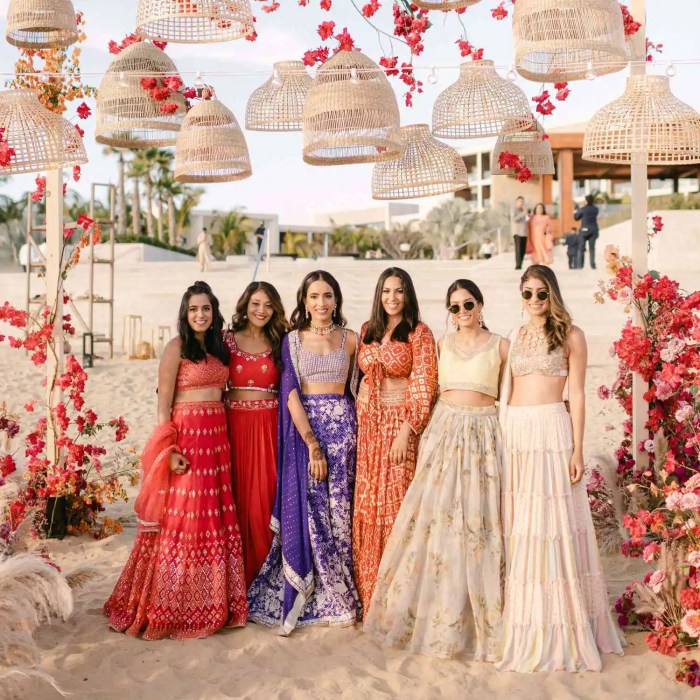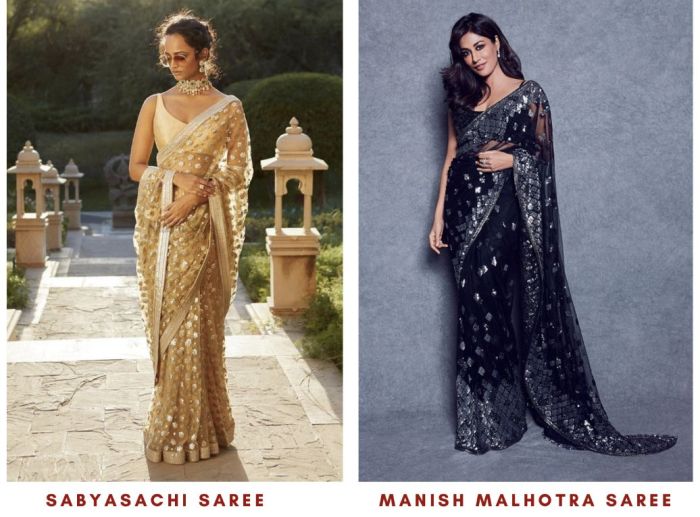Indian Wedding Guest Dresses: A Style Guide: Indian Dresses For Wedding Guest

Source: brides.com
Indian dresses for wedding guest – Attending an Indian wedding is a vibrant and joyous occasion, and choosing the right attire is crucial to celebrating the event in style. This guide provides a comprehensive overview of Indian dresses suitable for wedding guests, covering dress types, fabrics, color palettes, styling tips, budget considerations, and ethical choices.
Types of Indian Wedding Guest Dresses
Several traditional and contemporary dress options are perfect for Indian wedding guests. The choice often depends on the formality of the event, personal preference, and comfort level.
| Dress Type | Occasion Suitability | Typical Fabrics | Embellishments |
|---|---|---|---|
| Saree | Daytime or evening ceremonies, receptions | Silk, chiffon, georgette, brocade | Zari work, embroidery, stonework, prints |
| Lehenga Choli | Evening receptions, sangeet ceremonies | Silk, velvet, net, brocade | Heavy embroidery, mirror work, sequin work |
| Anarkali Suit | Daytime or evening functions, less formal events | Silk, chiffon, georgette, cotton | Embroidery, mirror work, gota patti |
| Salwar Kameez | Daytime functions, less formal events | Cotton, silk, chanderi | Embroidery, prints, block printing |
| Gown | Cocktail receptions, evening events | Silk, net, velvet | Embroidery, sequin work, beading |
Sarees offer a vast array of draping styles, from the classic Nivi drape to the more contemporary Bengali or Gujarati styles. Lehengas can range from simple A-line designs to elaborate flared styles with intricate detailing. Anarkalis offer varying sleeve lengths, necklines, and embellishments. Salwar kameez styles are incredibly diverse, encompassing everything from simple kurtas to heavily embellished designs. Gowns provide a modern, elegant alternative, often featuring intricate embroidery or embellishments.
Fabrics and Materials
The fabric significantly influences the overall look, feel, and drape of an Indian dress. Choosing the right fabric is essential for both comfort and aesthetic appeal.
- Silk: Luxurious, lustrous, and drapes beautifully. Requires delicate care.
- Brocade: Rich, textured fabric with intricate woven patterns. Can be heavy.
- Velvet: Soft, plush fabric with a luxurious feel, ideal for evening events. Can be delicate.
- Chiffon: Lightweight, sheer fabric with a flowing drape, suitable for warmer climates.
- Georgette: Similar to chiffon, but slightly more textured and opaque.
- Cotton: Breathable and comfortable, perfect for daytime events.
- Net: Sheer, delicate fabric often used for embellishments and layering.
Silk offers a luxurious sheen, while chiffon provides a more fluid drape. Velvet adds richness and warmth, whereas cotton prioritizes comfort. Proper care, including hand-washing or dry cleaning, extends the life of these fabrics.
Color Palettes and Trends
Color choices for Indian wedding guest attire are diverse and influenced by both current trends and cultural significance. Certain colors hold specific meanings in Indian weddings.
| Occasion | Suitable Colors | Complementary Accessories | Example Dress Description |
|---|---|---|---|
| Daytime Ceremony | Pastel shades, light blues, pinks, yellows | Light jewelry, minimal makeup | A pastel pink Anarkali suit in cotton with delicate embroidery. |
| Evening Reception | Rich jewel tones, deep reds, blues, greens | Statement jewelry, bold makeup | A deep red silk lehenga choli with heavy gold embroidery. |
| Sangeet Night | Bright, vibrant colors, fuchsia, turquoise | Colorful bangles, jhumkas | A vibrant fuchsia georgette saree with mirror work. |
For example, red signifies prosperity and good fortune, while yellow represents joy and optimism. Choosing colors that complement your complexion and the overall wedding theme is essential.
Styling and Accessories, Indian dresses for wedding guest
Accessories play a significant role in completing an Indian wedding guest look. The right accessories can elevate a simple outfit or add a touch of sophistication to a more elaborate one.
- Jewelry: Necklaces, earrings, bangles, bracelets, rings.
- Footwear: Heels, flats, embellished sandals.
- Handbags: Clutches, potlis.
- Hair accessories: Flowers, jeweled clips.
Matching jewelry to the dress’s color and embellishments creates a cohesive look. For instance, a heavy gold necklace complements a richly embroidered lehenga, while simpler jewelry suits a more understated Anarkali. Footwear choices should reflect the formality of the event and the dress style.
Budget Considerations
Finding stylish and affordable Indian wedding guest attire is achievable with careful planning and smart choices.
| Price Range | Dress Type | Fabric Suggestions | Tips for finding affordable options |
|---|---|---|---|
| Budget-friendly | Salwar Kameez, Anarkali | Cotton, chanderi | Shop online sales, consider renting, choose simpler embellishments |
| Mid-range | Lehenga Choli, Saree | Silk blends, georgette | Look for sales and discounts, buy from smaller boutiques |
| Luxury | Lehenga Choli, Designer Saree | Pure silk, brocade, velvet | Invest in timeless pieces, consider custom tailoring |
Choosing versatile pieces that can be accessorized differently for multiple occasions maximizes value. Shopping during sales or opting for simpler embellishments can significantly reduce costs without compromising style.
Ethical and Sustainable Choices
Supporting ethical and sustainable practices in the fashion industry is crucial. Choosing eco-friendly fabrics and brands promotes responsible consumption.
Prioritizing natural fabrics like organic cotton or handloom silks reduces the environmental impact. Several brands are committed to sustainable practices, focusing on fair labor practices and minimizing waste. Avoiding fast fashion and opting for durable, high-quality garments extends their lifespan and reduces textile waste.
Illustrative Examples

Source: getethnic.com
Here are three examples of Indian wedding guest outfits suitable for different occasions.
Daytime Ceremony Outfit: A pastel yellow Anarkali suit in lightweight cotton with delicate floral embroidery. Paired with minimal gold jewelry, nude heels, and a small clutch. The overall look is fresh, elegant, and appropriate for a daytime event.
Evening Reception Outfit: A deep blue velvet lehenga choli with intricate zari work. Accessorized with statement diamond jewelry, embellished heels, and a jeweled clutch. The rich fabric and embellishments create a sophisticated and glamorous look perfect for an evening reception.
Sangeet Night Outfit: A vibrant fuchsia georgette saree with mirror work and colorful gota patti detailing. Paired with colorful bangles, jhumkas, and bright heels. The bright color and playful embellishments create a fun and festive look ideal for a Sangeet celebration.
Helpful Answers
Can I wear a jumpsuit to an Indian wedding?
While traditional Indian attire is common, a stylish jumpsuit in rich fabrics and colors could be acceptable, especially for less formal events. However, it’s always best to check with the hosts if unsure.
What is the appropriate length for a wedding guest dress?
Knee-length or floor-length dresses are generally appropriate for Indian weddings. Very short dresses might be considered too informal.
How do I care for delicate fabrics like silk or brocade?
Delicate fabrics often require dry cleaning. Always check the care label before attempting to clean the garment yourself.
Where can I find affordable yet stylish Indian wedding guest dresses?
Online marketplaces, ethnic clothing stores, and even consignment shops can offer affordable options. Consider renting a dress if you only need it for one occasion.
